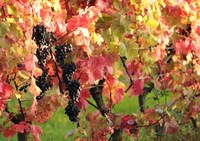Season of mists and extra fruitfulness

The latest Met Office figures show that England this year experienced its warmest, driest and sunniest summer since 2006. We had a whopping 588 hours of sunshine, making it the 7th sunniest summer since records began in 1929.
Now into October, the country is still benefitting from mild conditions. Autumn as we know it is expected to arrive later than usual this year, but we're promised a spectacular one when it does. Here, VisitEngland looks at the best places to make the most of it.
Raise a glass to autumn
Corks have been popping at vineyards across England this month as wine growers begin to celebrate what looks set to be a bumper harvest, thanks to the summer that was.
Julia Trustram-Eve, of English Wine Producers, says: "things are looking very good for the harvest this year thanks to the wonderful sunshine and temperatures we've experienced over this summer. The vines have had a great growing season and are very healthy, with plentiful and clean fruit. This also bodes well for 2014, as the vines will start in good condition for next year."
Sample English wines for yourself on a visit to one of the country's vineyards. In the heart of the Surrey Hills, Denbies Estate offers a daily wine tour, including a journey around the vines on its own custom train. Stay in one of Denbies' farmhouses, converted into a rustic guesthouse, and make a weekend of it, with Bed & Breakfast from just £85. Alternatively, visit Camel Valley in the South West. Recognised for its award-winning white and sparkling wines in particular, this Cornish vineyard benefits from a prime vine-growing location, set on the cusp of a valley that grabs every drop of sunshine.
A berry good harvest
Apples are already producing a bumper 2013 crop, and this year's low rainfall should mean firmer and tastier blackberries too. Promising for winter crumbles across the land. Bumper seed years are known as 'mast years'; a natural phenomenon where some species produce very large crops of seeds in some years, compared to almost none in others.
All this talk of a bumper crop will certainly prick the ears of the country's wildlife. Fruit eating birds and mammals can expect nothing short of a feast this autumn, when nuts, berries and seeds will be plentiful.
Matthew Parratt, a scientist at Forest Research, the research agency of the Forestry Commission, said: "Mast years are a great opportunity to experience nature at its best and with so much food around you're likely to spot wildlife around the trees, so it's a prime time to get out with the family and explore our woodland."
Head to the New Forest for the deer rut, one of the country's great natural splendours, which typically takes place in October. The New Forest Deer Safari, a 30-minute guided tractor and trailer tour, runs on Saturdays from noon until 5pm in Burley Park and is the best way to get up close and personal with England's largest land animal. Spend the night in a log cabin or wigwam at Sopley Lake (from £30 per night) for a true safari experience.
In Dorset, Brownsea Island is a haven for wildlife. Around 200 indigenous red squirrels live here and autumn is the best time of year for catching a glimpse of these famously-shy creatures. The resident peacocks and sika deer and easier to spot; so too are the numerous wading birds that fill the island's lagoon.
They're gold, not green
Observations suggest that this year's autumn colours will be more vibrant than ever. The early rainfall and hot summer of 2013 look set to prove a winning combination as woodlands and forests come alive with decadent golds, oranges and reds this month.
"From the beginning of October, visitors to woods and forests have seen the early waves of colour emerging and we're predicting that this stunning show of colour will reach its peak by the third week in October, through to the first week of November" said Simon Toomer, the Forestry Commission's director at the National Arboretum at Westonbirt, Gloucestershire. "There's only a very short window to see these beautiful changes occurring so we're encouraging people to get out and see what the forests and trees have on offer this autumn"
Calke Park in Derbyshire is home to some of the oldest trees in England and in autumn the various species take on a wide palette of burnt oranges, yellows, reds and browns. A National Nature Reserve, the park is also home to roaming red and fallow deer, providing a memorable sight during the autumn rut. Make a weekend of it and stay in one of four cottages in the grounds, including two unusual gate lodges and an 18th century farmhouse.
It's not just the trees providing colour at this time of year. The celebrated gardens at Anglesey Abbey in Cambridgeshire provide a beautiful backdrop for an afternoon's walk and never more so than in autumn, when berries along the pilgrim's lawn provide a sharp burst of colour.
Head Gardener at Anglesey Abbey, Richard Todd, says: "My favourite part about [Anglesey Abbey] is the cyclamen flowers which carpet the ground with pinks, purples and whites, and the winter berries on the bushes make every corner of the garden come alive with colour"

